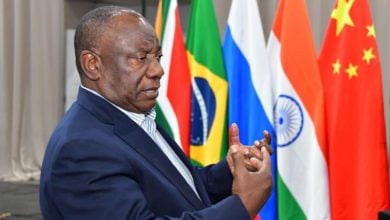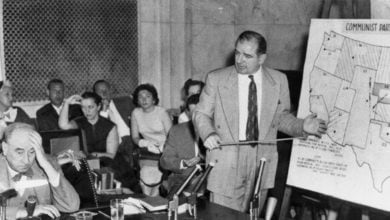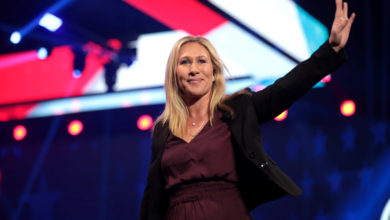This article is based on a talk given by PSL member Joel Northam.
We should see the FBI indictment of 13 Russian nationals opening a new phase in the federal government and mainstream media’s efforts to discredit the Black Lives Matter movement and independent left-wing politics.
What appeared first as the most laughable conspiracy theory nearly a year ago — “Russia funded riots in Ferguson” — has now become a primary talking point in the corporate-owned media, that “Russia stoked racial divisions” in America and infiltrated the Black Lives Matter movement to sow discord during the 2016 electoral race.
Under the guise of “national security” — namely protecting against the Russian threat — the Democrats in Congress recently reauthorized the sections of the Patriot Act which give the FBI and Justice Department vast mass surveillance authority without warrants. Jeff Sessions has already declared that his agency will be investigating so-called “Black identity extremists,” a mythical terror threat that only serves to justify a new COINTELPRO against the Black movement. Smearing that movement as Russian-influenced provides the Trump administration the perfect mechanism to do so.
While this campaign operates in the name of “protecting American democracy,” all progressives must reject it and call it what it is: a dangerous attack on political expression that will be primarily utilized against the independent left, not the right.
Charles Blow in the New York Times goes so far as to say that Black millennials were uninspired by the Clinton campaign because of Russia. Jill Stein of the Green Party and other independent left-wing candidates are being smeared as unwitting “tools of Russia.”
In fact, the attack on third parties in this way has become a major theme of the Russiagate phenomenon, that anyone who is expressing interest in third parties or expressing distrust of American political institutions, is really helping Russia polarize the country. With a straight face, so-called liberal media outlets are grilling Jill Stein as if one mysterious and badly written Facebook ad in Ohio delivered her tens of thousands of votes, as if she really did not have the right to run at all and get any votes; as if she were responsible for the Clinton campaign not campaigning in states like Wisconsin. Literally just because Jill Stein had dinner in the same room as Putin, there are wild allegations being thrown about her being an agent, and her campaign has also been brought before the Senate Intelligence committee and told to turn over internal documents.
Long-time left-wing journalists and alternative news sites have suddenly been labeled “fake news” or “Russian influenced,” downgraded in Facebook and Google algorithms to limit their reach.
Black activists who have appeared on RT or Sputnik have lost their jobs just for giving an interview. Of course, the corporate-controlled media only interviews Black organizers momentarily when the streets are ablaze with rebellion, and then go back to radio silence when activists launch campaigns and protests to address systemic racism. No young Black organizers are considered “political experts” in the mainstream media or given shows and podcasts or places in the opinion pages. Instead of being angry at Black organizers for going on “foreign-owned” media to get out their perspectives and spread the word about their campaigns, people should ask why it is so much harder to get a word in mainstream media.
There is a long history of using McCarthyite fear-mongering against the Black freedom movement. In the 1950s and 1960s, the presence of communists in the Black movement, and the rhetorical support that movement received from the Soviet Union and China, was used to discredit the movement’s leaders, to neutralize and expel its more radical elements and to deflect attention away from the movement’s critique of U.S. racism.
Right-wing politicians told their constituents and the media that the movement itself was a Russian plot, while so-called “sympathetic” politicians pressured leaders to disassociate themselves from long-time organizers because of their radical organizational connections. Every organization in the Black freedom movement, from the national to local level, faced this challenge.
Leading Black artists like Paul Robeson were permanently blacklisted, his career destroyed, because he refused to repudiate his conviction that Black people had no stake in a war against the Soviet Union. Black history professors lost their jobs. Leading radical Black trade unionists, from North Carolina to New York and Michigan, were driven out of their posts. A long list of Black-led community organizations were broken apart by the coordinated repression of the FBI and local police.
Whether the Russian-based Internet Research Agency, a company employing 80 individuals, actually produced some Black Lives Matter-themed content, sold some t-shirts, or even initiated a few Facebook events that drew small numbers, is irrelevant to the situation at hand. Anyone can create a Facebook post or event. The conditions that gave rise to the Black freedom movement are hundreds of years in the making, and the movement’s impetus, analysis, demands, initiative, and leadership are homegrown.
To wave off viral anti-racist content as “Russian propaganda” is an insult to all of Black America. It is in fact a form of racist misdirection, a new form of the old trope of Black people as “dupes” of a foreign power.
History shows that there’s no way for the Black freedom movement or any movement to duck the question of international politics. Some would like to keep silent on these issues and hope they blow over, but the truth is that this is a primary way that imperialism tries to discredit movements in its own country, and to ensure they don’t move in a radical direction. No movement can grow strong in the heart of imperialism if it is unable to stand up to this sort of propaganda, and answer it, and that’s the task of all us.






